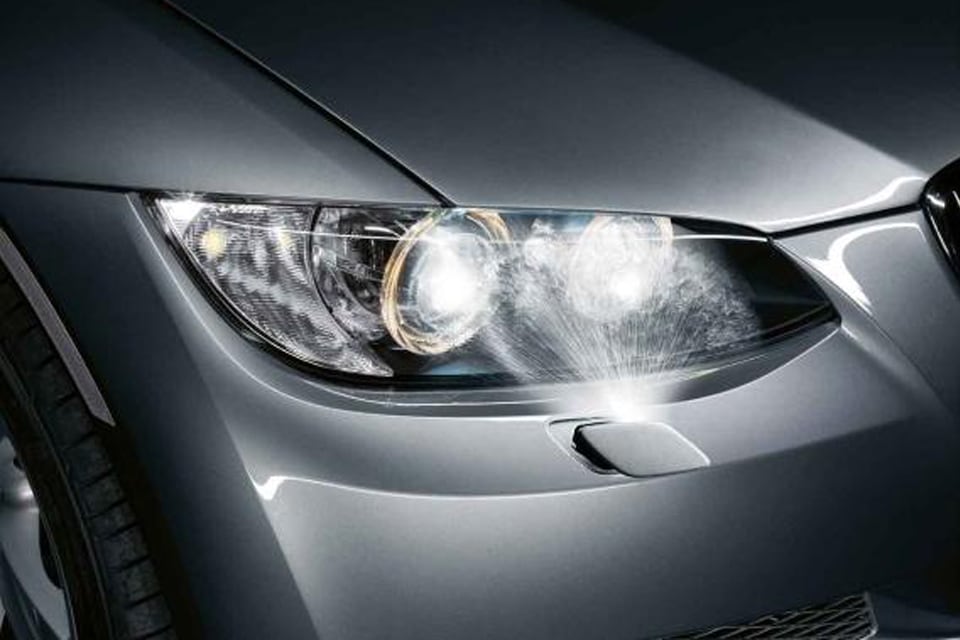
Types, device and principle of operation of the headlight washer
Content
- What is a headlight washer in a car
- Washer history
- Basic device and principle of operation of the device
- Washer types
- Correct operation of the headlight washer
- How to install a headlight washer with your own hands, how to turn it on and do it correctly
- Pros and cons of car headlight washers
- Questions and answers:
Technologies do not stand still, and the car market is constantly replenished with new models, which are equipped with all new equipment. Additional mechanisms and devices not only increase the safety of the vehicle, but also make its operation more comfortable. New technologies include magnetic suspension, night vision system and other equipment.
But if the presence of some systems is not necessary for the car, then some devices are simply necessary for it. An example of this is airbags (read about them in another review), ABS system etc. The same list includes a headlight washer. Consider the device, varieties and the principle by which this element will work if a car is equipped with it, as well as how to install it on your car.
What is a headlight washer in a car
When a car moves on a dirt road behind other vehicles, dust escaping from under the wheels of the car in front falls on the surfaces of the bumper, headlights, hood, windshield and radiator grill. Over time, these surfaces can become very dirty. If the cleanliness of the body does not affect the behavior of the car, but only the aesthetic part of the transport (for more details on how to protect the paintwork of the car, read here), then the windshield and every headlight in the car must always be clean.
Due to the dirty windshield, the driver does not see the road well and sooner or later will get into an accident. Cleaning the headlights is also important for good visibility in twilight conditions, especially if the bulbs do not provide enough light (this applies to ordinary bulbs, the light of which is powerful enough in the dark, but at the onset of twilight they seem to be nonexistent).

To eliminate this problem (the head optics are constantly getting dirty, especially if the car is operated in rural areas), automakers have equipped their models with a headlamp washer. The very idea of automatic local cleaning of glass surfaces is not new. For a long time, every car has received a windshield washer, and in some modern models there are also systems that clean the surfaces of the rear and side windows. The same principle applies to headlight washers.
As the name suggests, this system is used to keep optics clean. Later we will take a closer look at how the device works. But in short, a headlamp cleaner works in the same way as a windshield washer. When the driver, while driving, the car notices that the headlights do not shine so brightly due to dirt on the glass surface, he activates the system and removes the pollution.
Externally, the headlight washer resembles an analogue for cleaning the windshield. It can be brushed, that is, in addition to the nozzle, the system is equipped with small wipers, each of which cleans its own light diffuser (or rather its protective glass). There is also a jet version that performs the same function, only the cleaning effect is achieved by the pressure and the chemical composition of the washer.
What types of headlights is it used on
The headlight washer will definitely be installed on those car models with xenon in their headlights. As an option, this element can be ordered for vehicles with halogen headlights. Read more about other types of bulbs for cars, read in another article.
If we talk about halogen optics, then when it is dirty, the light beam dims, since it does not break through the pollution. In the case of the xenon counterpart, scattering or distortion of the light beam may occur. This often happens when ice has formed on the glass. Depending on the pollution, the headlights of cars can blind the drivers of oncoming traffic or incorrectly illuminate the roadway, which also affects road safety.
Washer history
The first developments of such an element began to appear on the 1996 Chevrolet Chevelle, as well as on several other models coming off the assembly lines, starting from that year. On the territory of the Soviet Union, headlight washers appeared in the famous "Chaika" (GAZ-14). This domestic car from the factory was equipped with a system, which cannot be said about Western car models (they were installed separately at the request of the buyer).
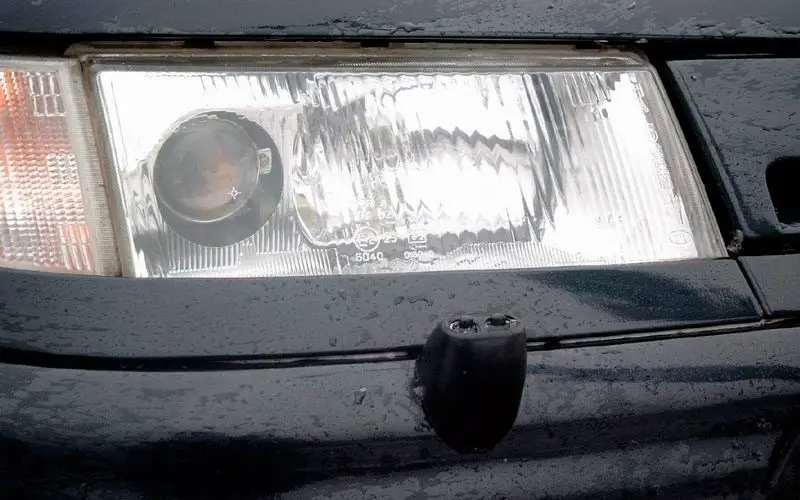
Also, this system was installed on export versions of the VAZ 2105 and 2106. These cars were exported to Scandinavia and Canada. But after a short period of time, the system lost its relevance and disappeared from the complete set. The reason for this was that the system consumed a large amount of cleaning fluid, and the spraying itself was not good at removing frozen dirt. The quality of the cleaning effect could be improved by installing headlight wipers.
Despite the fact that automakers stopped including this system in the factory configuration, if desired, it could be installed independently or, depending on the car model, ordered as an option. The situation changed when xenon appeared in the head optics. In accordance with European requirements, the system must be installed on a unit in which gas-discharge type light elements are used.
Basic device and principle of operation of the device
The design of the headlight washer is basically a windshield washer. A detergent is used there, at least one nozzle (spray) is required for each headlight. The liquid is supplied from a suitable reservoir. The electric pump generates high pressure, which effectively sprays onto the headlamp glass.
Depending on the modification, the system can operate separately from the general windshield washer circuit. For this, a separate or common tank can be used. There is also a type of washer that is integrated into the common windshield washer line. In the case of an individual drive, the system is controlled separately from the operation of the main circuit, which ensures the movement of the detergent through the tubes to the nozzles located in front of the windshield.
System operation depends on its modification. In the case of a stationary arrangement, pressing the appropriate switch turns on the pump and spray the liquid onto the optics. If a telescopic analogue is installed in the machine, then first the injector drive is triggered, pushing them to the desired height. Then the spraying process takes place. The cycle ends with the return of the nozzles to their place.
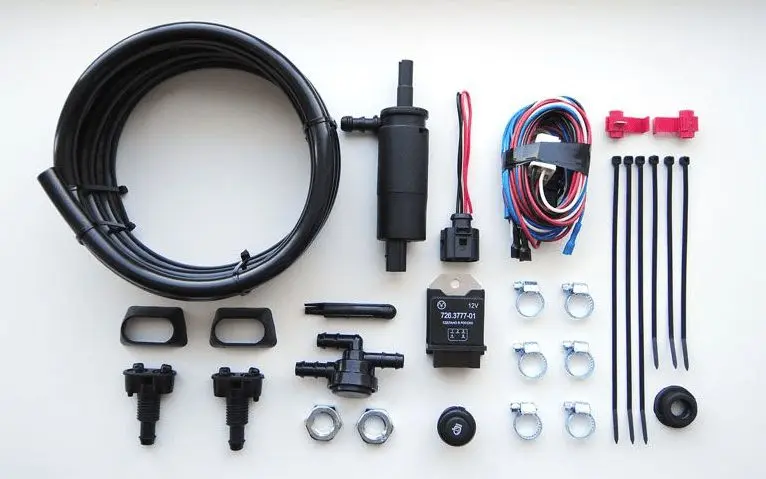
There is a manual and automatic type of headlight cleaning systems. As you might guess, the manual option is the cheapest and easiest to maintain and repair option. The system is activated by the appropriate button or washer switch when the lights are on.
As for the automatic version, it is integrated into the vehicle's on-board system. Basically, cars of the "Premium" segment are equipped with such a device. The microprocessor records the number and frequency of the washer operation, and, in accordance with the set algorithm, activates the cleaning of the optics. From the point of view of the efficiency of the working fluid, this is not beneficial, since the electronics are not guided by the contamination of the headlamp glass, and often activates the injectors when it is not necessary. And when you really need to remove dirt from the optics surface, there may not be enough detergent in the reservoir.
What does a headlight washer consist of?
The headlight washer device includes the following elements:
- Control system;
- The reservoir in which the cleaning solution is stored. Depending on the system model, the tank capacity is at least 25 sprays. The minimum tank capacity is 2.5 liters, but modifications of four liters are often found;
- The line through which the liquid is supplied from the tank to the sprayers;
- Electric pump (there can be one for the windscreen washer and for the headlight washer, or it can be individual for this system);
- Injectors. In the budget version, one nozzle is relied on one headlamp, but modifications with a double block for one element are more common. This ensures maximum detergent coverage of the headlamp glass surface.
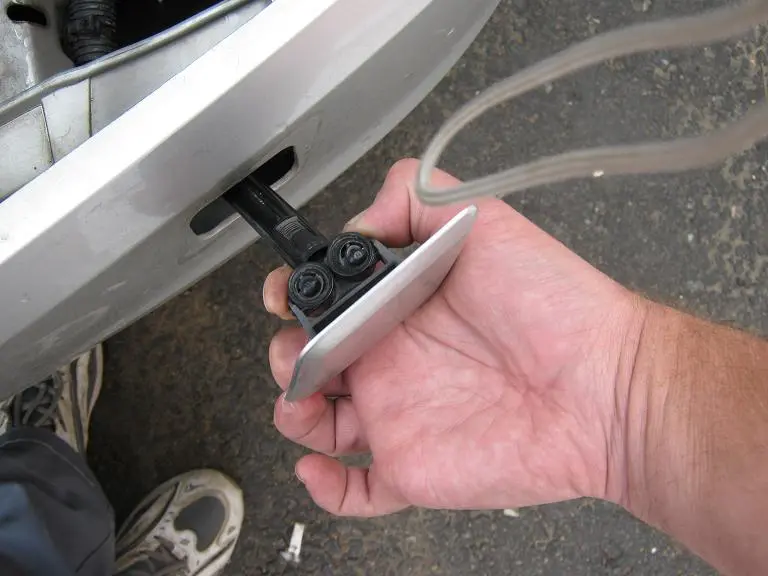
For the system to work, there must be a detergent in the tank. Usually this is hard water (it removes dirt better), but there are also special solutions, which include various detergents that destroy and soften dried dirt on the surface to be treated. In winter, ordinary water must be changed to an alcohol mixture so that the liquid in the tank does not freeze and because of this the container does not burst.
Although the capacity for storing cleaning fluid may vary, if the same tank is used to clean the windshield and headlights, it is better to choose the largest option, as far as the engine compartment allows.
The electric pump does more than just generate the pressure needed to operate the sprayers. He must create such a pressure that can wash off the limp dirt from the surface. This is necessary in order for the glass to be cleaned as quickly as possible. Control is carried out by the driver himself using a special switch (steering column, if the system is standard or in the case of using a separate button as an additional equipment).
Washer types
Of all the modifications of the headlight glass cleaning systems, two types of devices stand out. They differ from each other in design. The key operating principle remains unchanged. The design differs in the type of nozzles. It can be a stationary element (attached to the bumper), which is installed at the factory or during the modernization of the car. Also, in the case of factory equipment, a telescopic view can be used.
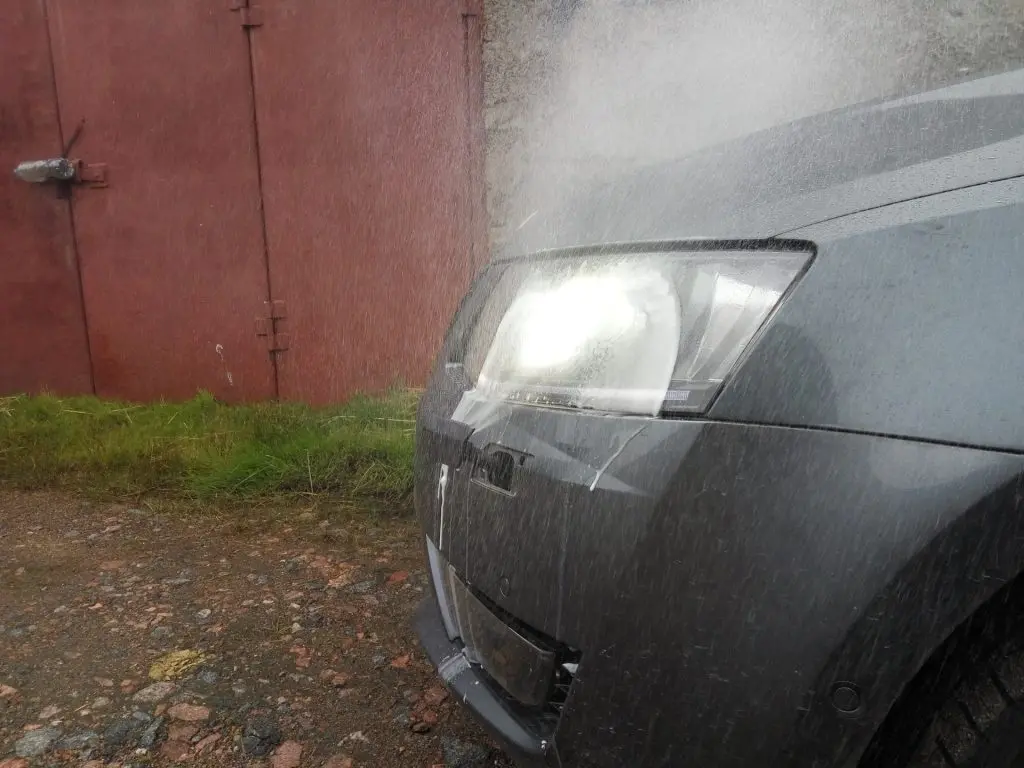
Another type of washer is brush, but it is already produced less often. In this case, a conventional electric pump is used, which does not create high pressure in the system. The jet is applied either to the glass or directly to the brushes that wipe the surface to be treated. This modification is gradually abandoned, since more often optics are equipped not with glass, but with transparent plastic. If you use brushes, then sand caught between the rubber band and the surface to be treated (and it will definitely be there) will certainly scratch the product, because of which you will have to either polish the headlights or change them.
The most reliable design is the stationary form, since there are no additional parts in its device that may fail. In such a modification, the only thing that can break down is the motor. Other malfunctions include depressurization of the line (a burst or breakdown of the hose from the fitting) and clogging of the sprayer if the driver pours dirty water or dirt gets into the tank. The number of diffusers per headlamp depends on the structural features of the optics.
Of the minuses of such modernization, only the visual effect - not every motorist likes protruding parts from the bumper, but this does not affect either the driving characteristics or the efficiency of the optics, and the sprayers are not visible from the passenger compartment.
As for the telescopic type, its presence is visually determined by slots in the bumper, which indicate that the module can be extended. The retractable jet mechanism is in great demand compared to the previous analogue, since the structure can be integrated into the bumper, and it will not be visible. The glass cleaning process differs only in that before spraying the liquid, the drive raises the nozzles from the bumper to the level of the center of the headlight.
Here is a short video of how such a system works:
Correct operation of the headlight washer
Although this system has a simple structure, as in the case of a conventional windshield washer, a few simple rules should be followed to keep all the actuators safe.
- At the onset of frost, the liquid in the tank must be replaced with an anti-freeze. This can be a mixture of water and alcohol or a special anti-freeze solution bought in a store. Even if the system is never used during the winter, the line will not freeze, which will cause it to be changed (at the moment of crystallization, the water expands greatly, which will lead to the destruction of not only the tank, but also the hoses).
- It is necessary to monitor the purity of the liquid in the tank. Some motorists fill in liquid through a special filter that is installed on the filler hole of the tank. If there are foreign elements in the container, sooner or later they will fall into the nozzle of the sprayer and affect the direction of the jet, and in the worst case, provoke its blockage. Clogged nozzles are replaced with new ones or cleaned.
- If xenon optics are installed in the car, then you should not rush to turn off the system in order to save the energy of the on-board system. This is because dirty headlight glass can distort the scattering of the light beam, which can negatively affect lighting efficiency.
In addition to this, the legislation of some countries obliges drivers to monitor the health of the xenon headlight washer, and a traffic police officer can check the system is working.
How to install a headlight washer with your own hands, how to turn it on and do it correctly
Now let's talk a little about how you can install a headlight cleaning system if it is not provided for by the design of the car. First of all, you should decide on what type of device you need. A stationary system is the easiest to install. In this case, the nozzles are mounted on top of the bumper so that the nozzles cover the glass surface as much as possible. The line is led inside the bumper to the corresponding reservoir.
The easiest way is to install an independent line with an individual pump, since this design does not imply dependence on the windshield washer, and these two systems do not need to be synchronized and configured so that the optics cleaner does not work every time the windshield spray is turned on.
The process of installing the highway is easier in the case of domestic cars. You can install an additional tank in them or drill into a standard tank and install an additional pump in it. Some foreign cars do not allow such modernization to be freely carried out due to the small engine compartment.
In auto parts and accessories stores, you can find kits that don't require bumper drilling. In this case, a special pad is used, fixed on double-sided tape, and the line is passed between the bumper and the headlight housing. In any case, each kit has an installation manual, which reflects the subtleties of the procedure.
The installation of the system begins with laying the line. First, an outlet fitting is drilled into which a high pressure pump will be connected. The hoses must be laid in the shortest possible way, but it is worth bypassing the moving and heating elements so that the line does not suffer.
Next, sprayers are installed. In the case of stationary, everything is very simple. They are mounted over the bumper so that the nozzles are directed towards the center of the optics. Some people install these elements by slightly offsetting them from the center of the headlight, and then set the direction of the nozzle using a thin needle. But in this case, the pressure will treat the surface unevenly, due to which one part of the glass will be better washed, while the other will remain intact. Therefore, the body of the external nozzle must be located just opposite the center of the optical element (not all headlights have bulbs in the center of the structure).
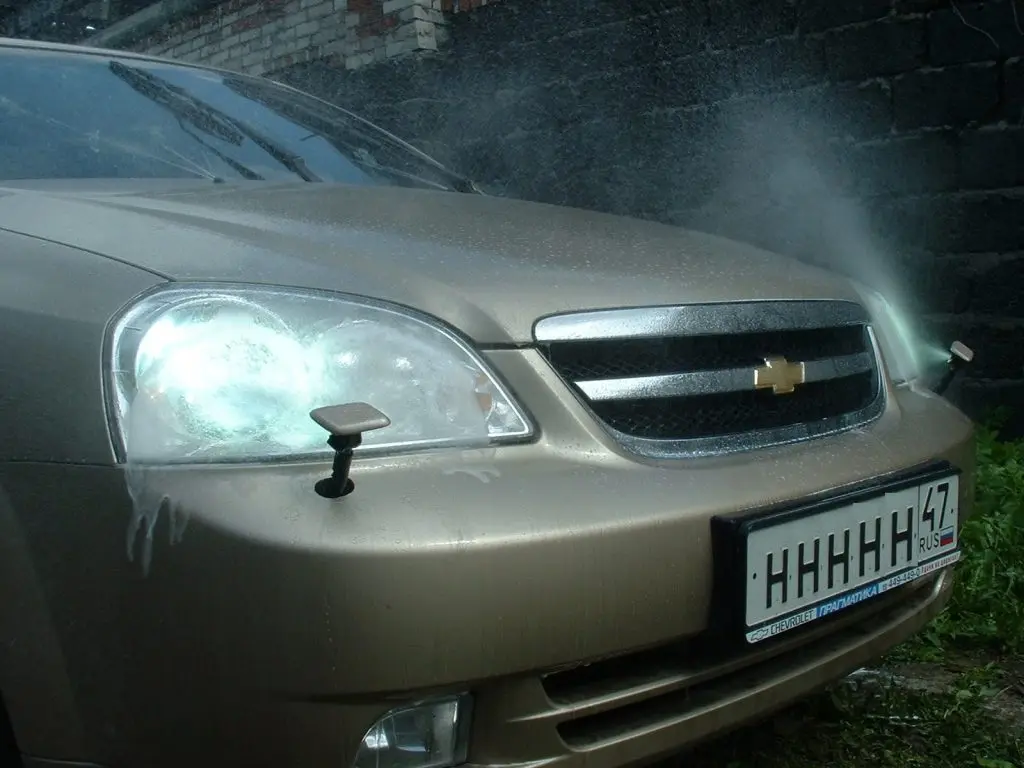

The same approach applies to telescopic cut-in jet elements. You need to drill a small hole so that you can correct its size. If there is no experience in such work, then you need to drill from the front side, and not from the inside of the bumper. Otherwise, paint chips may occur, which will be difficult to remove. The injectors are installed and adjusted in accordance with the instructions.
The pump itself is connected quite simply. The main thing is to observe the polarity. The connection is made in two ways. Each motorist determines for himself which of them is more acceptable in his case. The first way is through a separate button or a spring-loaded switch. In this case, the system is activated once by pressing the button.
The second way to connect the pump is through the contact group of the main washer switch or parallel with the main pump. With this installation, there is no need to embed an additional button, which can disrupt the design. But on the other hand, the headlamp washer will work every time the driver activates the washer. This will increase water consumption.
If the vehicle is equipped with a headlight washer system from the factory, the system can be activated in different ways. For example, in one model, double-pressing the windshield washer switch is sufficient for this. In other cases, this switch must be held down for a while. In the operating instructions, the automaker indicates how to activate the device in a particular case. However, there are some similarities. So, the system is not activated if the light sensor does not work (it will work only in the dark) or until the dipped beam is turned on, but not the dimensions (about why there are parking lights in the car, read separately).
Pros and cons of car headlight washers
Despite the obvious advantage of the optics cleaner, this system has several negative points.
- First, mention should be made of the quality of cleaning. Not in all cases, even a strong jet is able to cope with surface contamination. Most often this applies to insects adhering to the process of fast driving.
- When the vehicle is stationary, spraying is more effective than when the vehicle is in motion. The reason is that the air flow can change the direction of the jet, which can make the washer ineffective while driving. In this case, water scatters in all directions, and the glass remains dirty.
- If during the summer period it is not a problem to pour the required amount of water into the tank, then in winter this is associated with additional waste - you need to buy a washer and constantly carry a reserve of this liquid with you.
- The next disadvantage of this device is also associated with operation in the winter. If you activate spraying in the cold, then a low-quality liquid will most likely freeze on the surface of the headlight (in the case of the main washer, this effect is eliminated by the operation of the wipers and the temperature of the windshield, which is heated by the interior heating system). Because of this, the direction of the light beam can be distorted due to refraction. For this reason, you need to purchase a more expensive fluid in the washer.
- The same frost can cause blockage and failure of the injector drive. They can simply freeze to the bumper.
- Depending on the type of device, additional elements appear in the car that require maintenance, and in the event of a breakdown, repair.
So, with the advent of headlight washers, it has become easier for drivers to take care of their car. If any contamination can be removed during the washing process, it cannot be done while driving. This option is especially practical when the glass is dirty during rain - the driver does not need to get wet on the street to remove the dirt.
In conclusion, we offer a short video test of two headlight cleaning systems with wipers and sprayers:


Watch this video on YouTube
Questions and answers:
What headlights are needed for what? The dipped beam is designed to illuminate the road near the car (maximum 50-60 meters, but without dazzling oncoming traffic). The main beam is needed to illuminate the road for a long distance (if there is no oncoming traffic).
Which optics are best for a car? Laser optics shine best of all (it easily hits 600 meters), but it is very expensive, because it necessarily uses matrix technology (it cuts out a sector so as not to blind oncoming traffic).
What types of headlights are there? Halogen (incandescent lamp), xenon (gas-discharge), light-emitting diode (LED-lamps), laser (matrix light, adapting to vehicles moving in front).